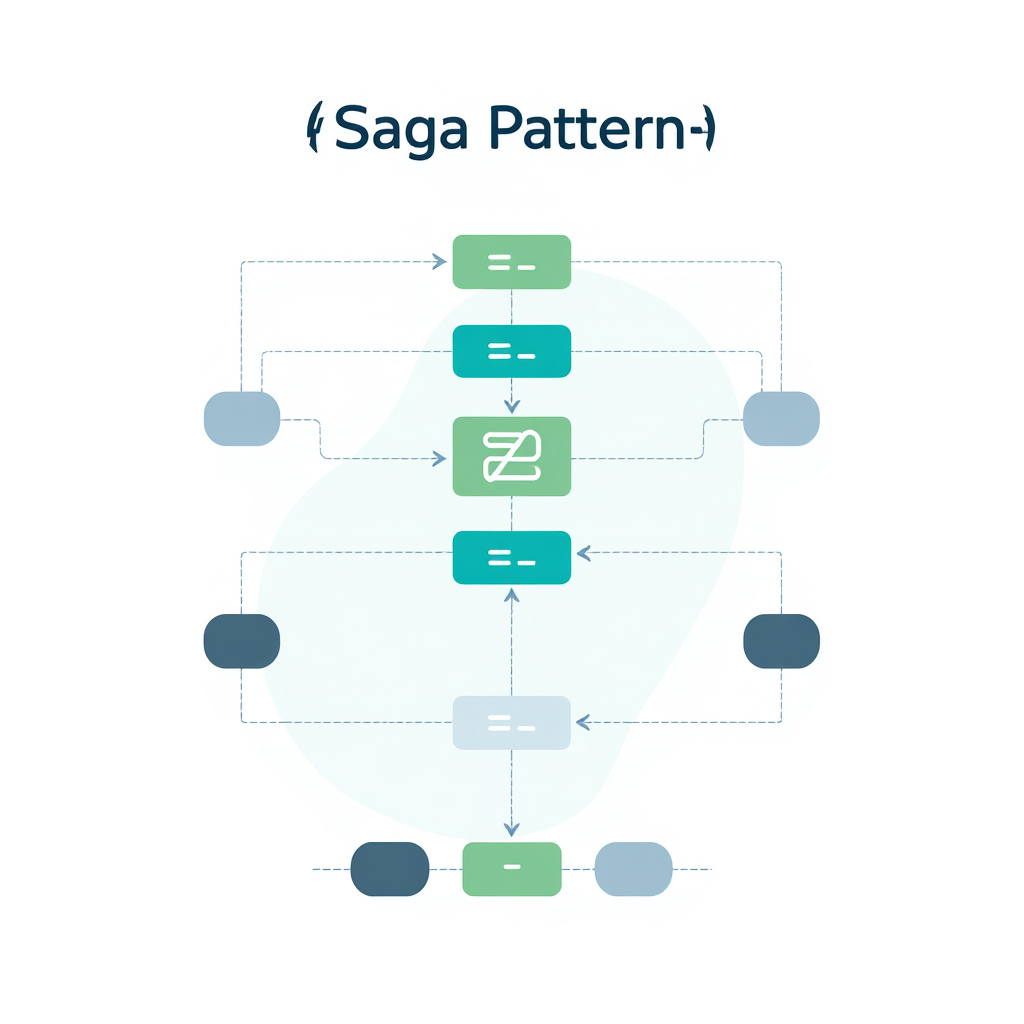Picture a Friday afternoon e-commerce disaster: a customer places a $500 order, your payment service charges their card, inventory gets reserved, but then the shipping service fails. You’re left with an angry customer, a charged card, and locked inventory that can’t be released without manual intervention. This is the painful reality of distributed transactions gone wrong.
In monolithic applications, database transactions solved these problems cleanly with ACID properties. But microservices break this model—each service manages its own data, and traditional transactions can’t span across service boundaries. When operations fail partway through a distributed workflow, you need a different approach.
This is where the saga pattern becomes essential for maintaining data consistency across microservices. Rather than relying on distributed locks or two-phase commits, sagas coordinate sequences of local transactions with built-in compensation logic to handle failures gracefully. As part of the broader microservices design patterns, the saga pattern specifically addresses the challenge of managing distributed transactions without sacrificing system resilience.
In this guide, you’ll learn how to implement saga patterns using both choreography and orchestration approaches, design effective compensating transactions, evaluate implementation frameworks, and adopt sagas successfully in your architecture.
What Is the Saga Pattern?
The saga pattern coordinates distributed transactions by breaking them into a sequence of local transactions, each managed by an individual microservice. Each step in the sequence either completes successfully or triggers compensating actions to undo previous steps.
Originally described in academic literature in the late 1980s, the pattern has become fundamental to microservices architecture. Each service in a saga maintains its own data consistency while participating in a larger distributed workflow.
A saga consists of several key components: participants (the individual microservices), compensation actions (rollback operations), steps (individual transaction units), and coordination mechanisms (choreography or orchestration approaches). Unlike traditional ACID transactions that lock resources across multiple systems, sagas embrace eventual consistency—they allow temporary inconsistent states while working toward a final consistent outcome.
The Problem: Distributed Transaction Challenges
Traditional database transactions rely on the ACID properties: Atomicity, Consistency, Isolation, and Durability. These properties work well within a single database but break down when operations span multiple services and databases.
Two-phase commit (2PC) protocols attempt to extend ACID properties across distributed systems by using a transaction coordinator that ensures all participants either commit or abort together. However, 2PC has significant limitations in microservices environments: it creates blocking scenarios where services wait indefinitely for coordinator responses, reduces system availability if any participant becomes unavailable, and creates tight coupling between services.
How Sagas Solve the Problem
Sagas address these challenges by replacing distributed transactions with a sequence of local transactions. Each service executes its local transaction independently and publishes events or messages about the results. If any step fails, the saga executes compensation actions to undo previously completed steps.
This approach provides several advantages: services remain loosely coupled, the system can continue processing even if some services are temporarily unavailable, and failures are handled gracefully through compensation rather than blocking operations.
The key insight is accepting eventual consistency—the system may be temporarily inconsistent during saga execution but will eventually reach a consistent state through either successful completion or compensation. This trade-off enables higher availability and better fault tolerance than traditional distributed transaction approaches.
Choreography vs Orchestration Approaches
Sagas can be implemented using two different coordination patterns: choreography and orchestration. Each approach has distinct characteristics and suits different architectural requirements.
Choreography-Based Sagas
In choreography-based sagas, services coordinate through events without central control. Each service listens for relevant events, processes them according to its local logic, and publishes new events to continue the saga workflow.
When a user places an order, the Order Service creates an order record and publishes an “OrderCreated” event. The Payment Service listens for this event, processes the payment, and publishes either “PaymentSucceeded” or “PaymentFailed”. The Inventory Service listens for successful payments and publishes inventory events, continuing the chain.
The benefits of choreography include high service autonomy—each service makes independent decisions about how to process events. Services remain loosely coupled since they only need to understand event contracts, not implementation details of other services. The approach also scales well since there’s no central bottleneck.
However, choreography has drawbacks. Understanding the complete workflow requires examining multiple services since there’s no single place defining the entire process. Debugging failures becomes complex when you need to trace events across multiple services.
Use choreography when you have simple workflows with well-defined steps, when teams prefer service autonomy, and when you want to avoid central points of failure.
Orchestration-Based Sagas
Orchestration uses a central coordinator (orchestrator) that manages the entire saga workflow. The orchestrator invokes each service in sequence, collects responses, and makes decisions about whether to proceed or initiate compensation.
The orchestrator maintains state about the saga’s progress, making it easier to understand and debug workflows. When failures occur, the orchestrator knows exactly which steps have completed and can invoke appropriate compensation actions in reverse order.
Benefits include clear workflow definition in a single place, easier debugging and monitoring, and simplified error handling. The orchestrator can implement sophisticated retry logic, timeouts, and failure handling strategies.
Use orchestration for complex workflows with multiple decision points, when you need clear visibility into workflow execution, and when centralised error handling and monitoring are priorities.
Decision Framework: Choosing Your Approach
The choice between choreography and orchestration depends on several factors:
Workflow complexity: Simple, linear workflows suit choreography. Complex workflows with conditional logic, loops, or sophisticated error handling benefit from orchestration.
Team structure: Conway’s Law suggests that choreography works well when teams prefer autonomy and minimal coordination. Orchestration fits better when you have centralised platform teams or need consistent governance across workflows.
Debugging requirements: If you need easy troubleshooting and clear visibility into workflow execution, orchestration provides better observability. Choreography requires more sophisticated monitoring to track events across services.
Designing Effective Compensating Transactions
Compensating transactions are the cornerstone of saga reliability. They undo the effects of previously completed steps when subsequent steps fail. Designing effective compensation requires understanding different compensation strategies and handling edge cases.
Compensation Logic Fundamentals
Compensation actions must be idempotent—executing them multiple times should produce the same result. This is essential because network failures, retries, or system crashes might cause compensation actions to be invoked more than once.
There are two main types of compensation: semantic and syntactic. Syntactic compensation directly reverses the effects of the original transaction—for example, if you debited $100 from an account, credit $100 back. Semantic compensation addresses the intent rather than the exact mechanics—if you reserved inventory items, semantic compensation might involve notifying customers of unavailability rather than simply unreserving the items.
Compensation Design Patterns
Reversal patterns directly undo the original operation. For a payment saga, if charging a credit card succeeds but shipping fails, the reversal compensation refunds the charge. This works well for operations with clear inverse actions.
Mitigation patterns address consequences without exact reversal. If a hotel reservation saga fails after confirming the booking but before charging the card, mitigation might involve sending an apology email and offering a discount rather than complex booking system reversals.
Retry patterns attempt the failed operation again, which can be appropriate when failures are likely to be transient. However, implement maximum retry counts and exponential backoff to avoid infinite loops.
Common Compensation Challenges
The most challenging scenario is when compensation itself fails. Design compensation actions to be as simple and reliable as possible. When compensation does fail, you need manual intervention processes or dead letter queues to capture failed compensations for later retry.
Race conditions can occur when new saga instances start while compensation is running for failed instances. Use correlation identifiers and idempotency keys to ensure operations don’t interfere with each other.
Implementation Framework Comparison
Several frameworks provide saga implementation support, each with different strengths and architectural assumptions.
Temporal.io
Temporal.io provides a comprehensive platform for durable workflow execution, with excellent saga support. Its key strength is durable execution—Temporal handles failures, retries, and state persistence automatically. Your saga logic appears to run continuously even when the underlying workers restart or crash.
Temporal’s programming model uses standard programming languages (Go, Java, Python, etc.) with special workflow and activity concepts. Workflows define the saga coordination logic, while activities represent the individual steps executed by each service.
Temporal suits complex workflows with sophisticated error handling requirements, applications needing strong reliability guarantees, and teams comfortable with learning Temporal’s programming model.
Apache Camel Saga EIP
Apache Camel provides saga support through its Enterprise Integration Pattern (EIP) library. Camel’s strength lies in its mature integration ecosystem and extensive connector library for various systems and protocols.
Camel sagas work well in integration-heavy environments where you’re already using Camel for message routing and transformation. The framework provides good flexibility for different coordination patterns and supports both choreography and orchestration approaches.
Use Camel when you’re already invested in the Camel ecosystem, need extensive integration capabilities, or have Java-based microservices.
Axon Framework
Axon Framework focuses on event sourcing and Command Query Responsibility Segregation (CQRS) architectures, with saga support built on top of these patterns. Sagas in Axon are event-driven and naturally fit choreographed coordination patterns.
Choose Axon when building event-sourced applications, when your team embraces CQRS patterns, or for Java-based systems with sophisticated event handling needs.
Framework Selection Guide
Consider your existing technology stack and team expertise. If you’re already using Java enterprise patterns, Camel might fit naturally. For event-sourced architectures, Axon provides integrated solutions. For maximum flexibility and language choice, Temporal offers the most comprehensive platform.
Evaluate operational requirements. Temporal requires running additional infrastructure but provides powerful operational features. Camel and Axon can be embedded in your applications but require more manual work for monitoring and failure handling.
Real-World Implementation Examples
Understanding saga patterns becomes clearer through concrete examples that show how different industries apply these concepts.
E-commerce Order Processing Saga
Consider a typical e-commerce order workflow: order creation, payment processing, inventory reservation, and shipping coordination.
Using choreography, the flow works like this: Order Service creates an order and publishes “OrderCreated”. Payment Service processes payment and publishes “PaymentProcessed”. Inventory Service reserves items and publishes “InventoryReserved”. Shipping Service schedules delivery and publishes “ShippingScheduled”.
For compensation, if shipping fails after payment and inventory steps succeed, the saga executes compensations in reverse order: unreserve inventory items, refund the payment, and mark the order as cancelled.
The compensation design varies by business requirements. Full refunds work for cancelled orders, but partial compensations might apply if items are substituted or shipping is delayed rather than cancelled entirely.
Financial Services Transfer Saga
Financial services require careful handling of money movement with audit trails and regulatory compliance. Consider a transfer between accounts at different banks: account validation, debit source account, credit destination account, and notification.
The saga ensures money is never lost or duplicated. If crediting the destination account fails after debiting the source, compensation credits the source account and creates audit records of the failed transfer.
Regulatory requirements often mandate specific compensation approaches. Rather than simple reversals, financial sagas might need to create offsetting transactions that preserve complete audit trails for compliance reporting.
Best Practices and Common Pitfalls
Successful saga implementations require attention to several key practices while avoiding common mistakes that can undermine reliability.
Implementation Best Practices
Design all saga operations to be idempotent from the start. This means each step can be safely retried without causing duplicate effects. Use unique identifiers, check for existing records before creating new ones, and design compensation actions that can run multiple times safely.
Implement comprehensive timeout handling for each saga step. Services might become unavailable or respond slowly, so define maximum wait times and appropriate actions when timeouts occur.
Use correlation identifiers to trace saga execution across all services and log entries. When debugging distributed failures, correlation IDs help reconstruct the complete flow of events and identify where problems occurred.
Monitor saga execution and failures actively. Track metrics like saga completion rates, average execution times, and failure patterns. Set up alerts for unusual failure rates or compensation execution spikes that might indicate systemic issues.
Common Anti-Patterns to Avoid
Don’t ignore compensation design until after implementing the main workflow. Compensation logic is often more complex than forward operations because it must handle partial states and edge cases. Design compensation actions alongside primary operations.
Avoid creating overly complex sagas that try to handle every possible edge case within the workflow itself. Instead, design for common success paths with well-defined compensation for failures, and handle truly exceptional cases through manual intervention processes.
Poor error handling and logging make saga debugging difficult. Each step should log enough information to understand what happened and why operations succeeded or failed. Include business context in log messages, not just technical details.
Testing Strategies
Unit test compensation logic thoroughly, including scenarios where compensation itself might fail. Mock external service dependencies and verify that compensations produce expected results under various failure conditions.
Integration testing should cover complete saga workflows, including happy path scenarios and various failure points. Use techniques like chaos engineering to randomly inject failures at different steps and verify that compensation logic responds correctly.
Migration and Adoption Strategy
Moving from monolithic transaction management to saga patterns requires careful planning and gradual implementation.
From Monolith to Sagas
Start by identifying workflows in your monolithic application that involve multiple business domains. These are good candidates for saga conversion because they naturally map to different microservices.
Begin with less critical workflows to gain experience with saga patterns before tackling mission-critical processes. This allows your team to learn the operational aspects of running sagas without risking core business functions.
Implement sagas alongside existing monolithic workflows initially. This provides fallback options if saga implementations encounter issues and allows for gradual traffic migration once you’re confident in the saga approach.
Team and Organisational Considerations
Saga patterns require different thinking about failure handling and consistency than traditional transaction approaches. Invest in training developers on eventual consistency concepts, compensation design, and distributed system debugging techniques.
DevOps teams need new monitoring and debugging capabilities for distributed workflows. Implement distributed tracing, correlation ID tracking, and business-level monitoring before rolling out saga implementations broadly.
Update change management processes to account for saga dependencies. Changes to one service in a saga might require coordinated deployments or careful versioning to avoid breaking existing workflows.
Conclusion and Next Steps
The saga pattern provides a robust approach to managing distributed transactions in microservices architectures. By breaking complex workflows into sequences of local transactions with compensation logic, sagas enable better fault tolerance and service autonomy than traditional distributed transaction approaches.
Choose choreography for simple workflows where service autonomy is paramount, or orchestration for complex workflows requiring centralised control and visibility. Design compensation logic carefully, making it idempotent and as reliable as possible.
For implementation, evaluate frameworks based on your existing technology stack and team expertise. Temporal.io offers comprehensive workflow capabilities, while Camel and Axon integrate well with specific architectural patterns.
Start your saga adoption with less critical workflows to build experience, then gradually expand to mission-critical processes. Invest in monitoring, logging, and team training to support the operational requirements of distributed workflow management.
The saga pattern isn’t just a technical solution—it’s an architectural approach that embraces the realities of distributed systems while providing practical tools for managing complexity and failures gracefully.
FAQ
Q: When should I choose sagas over distributed transactions? A: Choose sagas when you need loose coupling between services, high availability, and can accept eventual consistency. Use distributed transactions only when you need strict ACID properties and can tolerate the performance and availability trade-offs.
Q: How do I handle failures in compensation logic? A: Design compensation actions to be as simple and reliable as possible. Implement dead letter queues for failed compensations, manual intervention processes, and detailed logging to track compensation failures for later analysis and retry.
Q: Can sagas work with existing monolithic systems? A: Yes, sagas can be implemented gradually. Start by extracting individual services from your monolith and implementing sagas between the extracted services and the remaining monolith. This allows for incremental migration.
Q: How do I monitor saga execution across multiple services? A: Use distributed tracing with correlation IDs, implement centralised logging, and create business-level dashboards that track saga completion rates, failure patterns, and compensation execution. Tools like Jaeger or Zipkin can help with distributed tracing.
Q: What’s the performance impact of using sagas? A: Sagas typically have higher latency than local transactions due to network calls and coordination overhead. However, they provide better availability and throughput in distributed systems by avoiding blocking and allowing services to operate independently.












